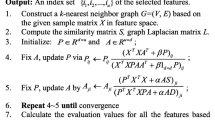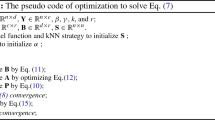Abstract
Recently, many feature selection algorithms based on non-negative matrix factorization have been proposed. However, many of these algorithms only consider unilateral information about global or local geometric structure normally. To this end, this paper proposes a new feature selection algorithm called double feature selection algorithm based on low-rank sparse non-negative matrix factorization (NMF-LRSR). Firstly, to reduce the dimensions effectively, NMF-LRSR uses non-negative matrix factorization as the framework to further reduce the dimension of the feature selection which is originally a dimension reduction problem. Secondly, the low-rank sparse representation with the self-representation is used to construct the graph, so both the global and intrinsic geometric structure information of the data could be taken into account in the process of feature selection, which makes full use of the information and makes the feature selection more accurate. In addition, the double feature selection theory is used to this paper, which makes the result of feature selection more accurate. NMF-LRSR is tested on the baseline and the other six algorithms in the literature and evaluated them on 11 publicly available benchmark datasets. Experimental results show that NMF-LRSR is more effective than the other six feature selection algorithms.










Similar content being viewed by others
Explore related subjects
Discover the latest articles, news and stories from top researchers in related subjects.References
Bach F (2008) Consistency of the group Lasso and multiple kernel learning. J Mach Learn Res 9(2):1179–1225
Banerjee M, Pal N (2015) Unsupervised feature selection with controlled redundancy (UFeSCoR). IEEE Trans Knowl Data Eng 27(12):3390–3403
Belkin M, Niyogi P (2001) Laplacian eigenmaps and spectral techniques for embedding and clustering. Adv Neural Inf Process Syst 14:585–591
Bhattacharya A, Goswam R, Mukherjee K (2019) A feature selection technique based on rough set and improvised PSO algorithm (PSORS-FS) for permission based detection of Android malwares. Int J Mach Learn Cybern 10(7):1893–1907
Cai D, He X, Han J, Huang TS (2011) Graph regularized nonnegative matrix factorization for data representation. IEEE Trans Pattern Anal Mach Intell 33(8):1548–1560
Cai D, Zhang C, He X (2010) Unsupervised feature selection for multi-cluster data. In: Proceedings of the 16th ACM SIGKDD international conference on knowledge discovery and data mining, pp 333–342
Chen Z, Wu C, Zhang Y, Huang Z (2015) Feature selection with redundancy-complementariness dispersion. Knowl-Based Syst 89:203–217
Deutsch HP (2004) Principle component analysis. Derivatives and internal models
Du S, Wang W, Ma Y (2016) Low rank sparse preserve projection for face recognition. In: Control & decision conference IEEE
Golub G, Reinsch C (1970) Singular value decomposition and least squares solutions. Numer Math 14(5):403–420
Gu B, Sun X, Sheng V (2016) Structural minimax probability machine. IEEE T Neural Netw Learn Syst 1(7):1–11
Guyon I, Elisseeff A (2003) An introduction to variable and feature selection. J Mach Learn Res 3:1157–1182
He W, Zhu X, Cheng D, Hu R, Zhang S (2017) Unsupervised feature selection for visual classification via feature-representation property. Neurocomputing 236:5–13
He X, Cai D, Niyogi P (2005) Laplacian score for feature selection. In: Advances in neural information processing systems
Hou C, Nie F, Yi D, Wu Y (2011) Feature selection via joint embedding learning and sparse regression. In: Proceedings of the international joint conference on artificial intelligence, p 1324
Hu R, Zhu X, Cheng D, He W, Yan Y, Song J, Zhang S (2017) Graph self-representation method for unsupervised feature selection. Neurocomputing 220:130–137
Kohavi R, John GH (1997) Wrappers for feature subset selection. Artif Intell 97(1–2):273–324
Labani M, Moradi P, Ahmadizar F, Jalili M (2018) A novel multivariate filter method for feature selection in text classification problems. Eng Appl Artif Intell 70:25–37
Lee DD, Seung HS (1999) Learning the parts of objects by non-negative matrix factorization. Nature 401:788–791
Lee DD, Seung HS (2001) Algorithms for non-negative matrix factorization. In: Advances in neural information processing systems, pp 556–562
Li X, Zhang H, Zhang R, Liu Y, Nie F (2018) Generalized uncorrelated regression with adaptive graph for unsupervised feature selection. IEEE Trans Neural Netw Learn Syst 99:1–9
Lipovetsky S (2009) PCA and SVD with nonnegative loadings. Pattern Recognit 42(1):68–76
Liu G, Lin Z, Yan S, Sun J, Yu Y, Yi M (2010) Robust recovery of subspace structures by low-rank representation. IEEE Trans Pattern Anal Mach Intell 35(1):171–184
Liu Y, Liu K, Zhang C, Wang J, Wang X (2017) Unsupervised feature selection via diversity-induced self-representation. Neurocomputing 219(1):350–363
Meng Y, Shang R, Jiao L, Zhang W, Yang S (2018) Dual-graph regularized non-negative matrix factorization with sparse and orthogonal constraints. Eng Appl Artif Inte 69:24–35
Meng Y, Shang R, Jiao L, Zhang W, Yuan Y, Yang S (2018) Feature selection based dual-graph sparse non-negative matrix factorization for local discriminative clustering. Neurocomputing 290:87–99
Moradi P, Rostami M (2015) A graph theoretic approach for unsupervised feature selection. Eng Appl Artif Intell 44:33–45
Moradi P, Rostami M (2015) Integration of graph clustering with ant colony optimization for feature selection. Knowl-Based Syst 8:144–161
Nie F, Xiang S, Jia Y, Zhang C (2008) Trace ratio criterion for feature selection. Assoc Adv Artif Intell 2:671–676
Nie F, Huang H, Cai X, Ding C (2010a) Efficient and robust feature selection via joint 2,1-norms minimization. In: Advances in neural information processing systems, pp 1813–1821
Nie F, Xu D, Tsang IW, Zhang C (2010) Flexible manifold embedding: a framework for semi-supervised and unsupervised dimension reduction. IEEE Trans Image Process 19(7):1921–1932
Nie F, Zeng Z, Tsang IW, Xu D, Zhang C (2011) Spectral embedded clustering: a framework for in-sample and out-of-sample spectral clustering. IEEE Trans Neural Netw 22(11):1796–1808
Nie F, Xiang S, Liu Y, Hou C, Zhang C (2012) Orthogonal vs. uncorrelated least squares discriminant analysis for feature extraction. Pattern Recognit Lett 33(5):485–491
Paatero P, Tapper U (1994) Positive matrix factorization: a non-negative factor model with optimal utilization of error estimates of data values. Environmetrics 5(2):111–126
Qiao L, Chen S, Tan X (2010) Sparsity preserving projections with applications to face recognition. Pattern Recognit 43(1):331–341
Rakhlin A, Caponnetto A (2007) Stability of k-means clustering. In: Advances in neural information processing systems, p 1121
Ren Z, Sun Q, Wu B, Zhang X, Yan W (2019) Learning latent low-rank and sparse embedding for robust image feature extraction. IEEE Trans Image Process 99(9):1
Robnik-Šikonja M, Kononenko I (2003) Theoretical and empirical analysis of relief and relief. Mach Learn 53(1–2):23–69
Shang F, Jiao L, Wang F (2012) Graph dual regularization non-negative matrix factorization for co-clustering. Pattern Recognit 45(6):2237–2250
Shang F, Liu Y, Wang F (2011) Learning spectral embedding for semi-supervised clustering. In: 2011 IEEE 11th international conference on data miming, pp 597–606
Shang R, Wang W, Stolkin R, Jiao L (2016) Subspace learning-based graph regularized feature selection. Knowl-Based Syst 112:152–165
Shang R, Chang J, Jiao L, Xue Y (2019) Unsupervised feature selection based on self-representation sparse regression and local similarity preserving. Int J Mach Learn Cybern 10(4):757–770
Strehl A, Ghosh J (2002) Cluster ensembles—a knowledge reuse framework for combining multiple partitions. J Mach Learn Res 3(12):583–617
Vergara JR, Estévez PA (2014) A review of feature selection methods based on mutual information. Mach Learn 24:175–186
Wan Y, Chen X, Zhang J (2018) Global and intrinsic geometric structure embedding for unsupervised feature selection. Expert Syst Appl 93:134–142
Wang J, Yao J, Sun Y (2014) Semi-supervised local-learning-based feature selection. In: International joint conference on neural networks, pp 1942–1948
Wang A, An N, Chen G, Li L, Alterovitz G (2015) Accelerating wrapper-based feature selection with K-nearest-neighbor. Knowl-Based Syst 83:81–91
Wang S, Tang J, Liu H (2015) Embedded unsupervised feature selection. In: International conference on swarm intelligence
Wang S, Wang H (2017) Unsupervised feature selection via low-rank approximation and structure learning. Knowl-Based Syst 44:70–79
Wang C, He Q, Shao M, Hu Q (2018) Feature selection based on maximal neighborhood discernibility. Int J Mach Learn Cyb 9(11):1929–1941
Wu M, Schölkopf B (2006) A local learning approach for clustering. In: Advances in neural information processing systems, pp 1529–1536
Xiao S, Tan M, Xu D (2014) Weighted block-sparse low rank representation for face clustering in videos. In: European conference on computer vision, pp 123–138
Xu W, Gong Y (2004) Document clustering by concept factorization. In: Proceedings of the 27th annual international ACM SIGIR conference on research and development in information retrieval, pp 202–209
Xu Z, King I, Lyu RT, Jin R (2010) Discriminative semi-supervised feature selection via manifold regularization. IEEE Trnas Neural Netw 21(7):1033–1047
Yan H, Yang J (2015) Sparse discriminative feature selection. Pattern Recognit 48(5):1827–1835
Yang Y, Shen HT, Ma Z, Huang Z (2011) L2,1-norm regularized discriminative feature selection for unsupervised learning. In: Proceedings-international joint conference on artificial intelligence, p 1589
Zheng M, Bu J, Chen C, Wang C, Zhang L, Qiu G, Cai D (2011) Graph regularized sparse coding for image representation. IEEE Trans Image Process 20(5):1327–1336
Zhou L, Lu D, Fujita H (2015) The performance of corporate financial distress prediction models with features selection guided by domain knowledge and data mining approaches. Knowl-Based Syst 85:52–61
Zhou Q, Zhou H, Li T (2016) Cost-sensitive feature selection using random forest: selecting low-cost subsets of informative features. Knowl-Based Syst 95:1–11
Zhu P, Zuo W, Zhang L, Hu Q, Shiu S (2015) Unsupervised feature selection by regularized self-representation. Pattern Recognit 48(2):438–446
Zhu P, Zhu W, Wang W, Zuo W, Hu Q (2017) Non-convex regularized self-representation for unsupervised feature selection. Image Vis Comput 60:22–29
Zhuang L, Gao S, Tang J, Wang J, Lin Z, Ma Y, Yu N (2015) Constructing a non-negative low rank and sparse graph with data-adaptive features. Image Process 24(11):3717–3728
Acknowledgements
This work was partially supported by the National Natural Science Foundation of China under Grants Nos. 61773304, 61836009, 61871306, 61772399 and U1701267, the Fund for Foreign Scholars in University Research and Teaching Programs (the 111 Project) under Grants No. B07048, the Key Laboratory Fund 61421010402, and the Program for Cheung Kong Scholars and Innovative Research Team in University under Grant IRT1170.
Author information
Authors and Affiliations
Corresponding author
Additional information
Publisher's Note
Springer Nature remains neutral with regard to jurisdictional claims in published maps and institutional affiliations.
Rights and permissions
About this article
Cite this article
Shang, R., Song, J., Jiao, L. et al. Double feature selection algorithm based on low-rank sparse non-negative matrix factorization. Int. J. Mach. Learn. & Cyber. 11, 1891–1908 (2020). https://doi.org/10.1007/s13042-020-01079-6
Received:
Accepted:
Published:
Issue Date:
DOI: https://doi.org/10.1007/s13042-020-01079-6




